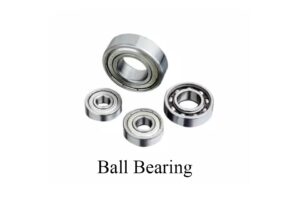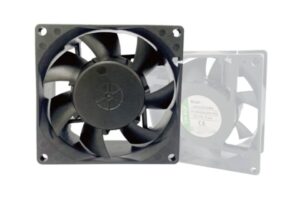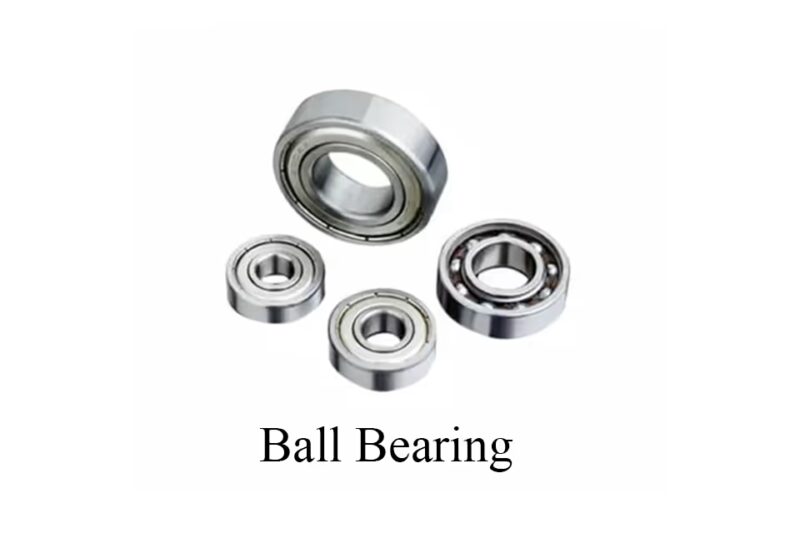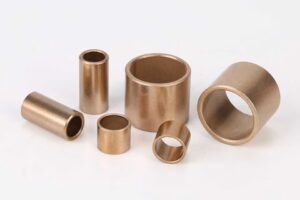Les différences entre les paliers lisses de ventilateur et les roulements à billes représentent une distinction cruciale en ingénierie mécanique, ayant un impact sur l'efficacité, les performances et l'adéquation des applications dans diverses industries.
Les roulements à billes se composent de bagues intérieures et extérieures avec des éléments roulants (billes) entre elles, ce qui facilite une friction plus faible et permet un fonctionnement à grande vitesse, les rendant idéaux pour les applications qui nécessitent un mouvement précis et peuvent tolérer le bruit, comme les moteurs industriels et les processeurs d'ordinateur.
En revanche, les paliers lisses, ou paliers simples, utilisent un manchon cylindrique qui supporte directement l'arbre, s'appuyant sur un mince film de lubrifiant pour minimiser la friction.
Cette conception leur permet d'exceller dans des environnements plus silencieux et des applications avec des exigences de charge modérées, telles que l'électronique grand public et les machines agricoles.
Il est à noter que le choix entre ces deux types de roulements a des implications significatives pour les caractéristiques de performance telles que la capacité de charge, la dissipation thermique et les exigences de maintenance.
Les roulements à billes sont connus pour leur durabilité et leur capacité à supporter des vitesses et des charges plus élevées, offrant ainsi une durée de vie prolongée allant jusqu'à 50 000 heures dans des conditions optimales. Inversement, les paliers lisses ont généralement une durée de vie plus courte, souvent entre 25 000 et 30 000 heures, et bien qu'ils soient économiques et plus faciles à entretenir, ils peuvent générer plus de chaleur et sont plus sensibles à l'usure et à la contamination.
Les controverses entourant le choix des types de roulements se concentrent souvent sur les compromis entre les coûts initiaux et les économies opérationnelles à long terme. Bien que les paliers lisses puissent sembler plus économiques au départ, les performances supérieures et la longévité des roulements à billes peuvent offrir une meilleure valeur à long terme, en particulier dans les environnements à forte demande.
Les préférences des consommateurs ont évolué ces dernières années, beaucoup optant pour les paliers lisses dans les applications sensibles au bruit tout en reconnaissant les avantages des roulements à billes dans les scénarios critiques en termes de performances.
Comprendre les différences entre les paliers lisses de ventilateur et les roulements à billes est essentiel pour les ingénieurs comme pour les consommateurs, car cela éclaire les décisions concernant le choix des roulements en fonction des besoins opérationnels spécifiques, des contraintes d'espace et des capacités de maintenance, influençant finalement l'efficacité et la fiabilité des machines dans divers secteurs.
Conception et Construction
Aperçu des Types de Paliers
Les roulements à billes et les paliers lisses sont deux types de roulements distincts utilisés dans diverses applications, chacun avec des caractéristiques de conception et des matériaux de construction uniques.
Un roulement à billes se compose d'une bague intérieure et d'une bague extérieure, avec une série de billes situées entre elles, maintenues en place par une cage. Cette conception permet une friction réduite et des performances améliorées, en particulier dans les applications qui nécessitent de la précision.
En contraste, les paliers lisses, également connus sous le nom de paliers simples, sont façonnés comme un manchon qui s'adapte directement sur l'arbre, créant un petit jeu rempli de lubrifiant.
Matériaux Utilisés
La construction des roulements à billes implique généralement des composants en acier trempé finis avec précision, offrant une exactitude et une longévité accrues. Cette fabrication de précision se traduit par un ajustement serré, permettant aux roulements à billes de supporter efficacement des vitesses et des charges plus élevées.
Conversely, sleeve bearings are often made from porous, powdered metals, which are produced using a sintering process. These materials can include polyamide, Teflon, rubber, ceramic, bronze, and various composites, allowing for a range of properties suited to different applications.
Considérations de Taille et d'Espace
In terms of physical dimensions, ball bearings are generally more compact in width compared to sleeve bearings, which tend to have a longer profile.
Despite this, sleeve bearings can be advantageous in applications where space is limited and heavier loads need to be supported. Their design allows for the accommodation of larger load capacities within tighter spaces, although they are susceptible to failure from contamination due to their open construction.
Lubrification et Entretien
Both types of bearings require lubrication to maintain performance and prevent failure.
Ball bearings can be sealed for life using thick lubricants that are less prone to evaporation, enhancing their reliability. In contrast, sleeve bearings have a more open design that allows for only a fixed amount of lubricant, which can evaporate more easily.
This difference in lubrication approach highlights the maintenance needs that must be considered during the selection process for a bearing type.
Principes de Fonctionnement
Paliers Lisses
Sleeve bearings, also known as plain bearings, function by supporting a rotating shaft or journal within a cylindrical sleeve. They rely on a thin film of lubricant to minimize direct contact between the bearing surface and the shaft, which reduces friction and wear during operation.
These bearings excel in applications involving rotary and linear motion due to their ability to evenly distribute loads and absorb vibrations. They are particularly suited for applications requiring high-frequency oscillatory motion, such as automotive suspensions and robotic linkage systems.
One significant characteristic of sleeve bearings is their design, which allows them to be more compact compared to other types of bearings. This compactness enables them to carry heavier loads in constrained spaces.
However, they are generally limited to lower speeds compared to rolling element bearings and tend to generate heat due to friction, which can lead to premature failure if not managed properly.
Roulements à Billes
Ball bearings, classified as antifriction bearings, employ rolling elements (balls) to reduce friction between the inner and outer races of the bearing.
This design allows them to carry both radial and thrust loads efficiently, making them versatile for various applications ranging from conveyor systems to household appliances. The rolling mechanism in ball bearings enables them to operate at higher speeds with lower heat generation compared to sleeve bearings, thereby improving performance and longevity under demanding conditions.
The operational efficiency of ball bearings is also contingent upon several factors, including the inner diameter, outer diameter, and width requirements, as well as the application-specific radial, axial, and thrust loads.
The choice of materials and proper installation techniques are crucial for minimizing noise and ensuring optimal performance, highlighting the need for careful consideration when selecting the appropriate bearing type for specific applications.
Caractéristiques de Performance
Efficacité et Dissipation Thermique
Cooling fans are critical in maintaining optimal operating temperatures across various applications, and the choice of bearing significantly impacts their efficiency.
Sleeve bearings, while generally quieter and cost-effective, have limitations in their heat-dissipating capabilities, making them more suitable for low-temperature applications.
In contrast, ball bearings, including hybrid ceramic options, excel in high-temperature environments due to their superior heat dispersive characteristics. Their design, which allows for better conduction of heat through a larger surface area, ensures consistent performance under demanding conditions.
A study by the National Renewable Energy Laboratory (NREL) indicates that well-maintained cooling fans can achieve energy savings of up to 30%, emphasizing the importance of selecting the right bearing type for effective heat management.
Niveaux sonores
Noise generation is a notable difference between sleeve and ball bearings. Ball bearings tend to produce more noise, which can be a disadvantage in noise-sensitive environments such as residential settings.
However, their reliability in high-demand applications, such as data centers and high-performance computing, often outweighs the noise concerns.
In contrast, sleeve bearings are preferred in applications where quiet operation is essential, providing a more subdued noise profile.
The installation and operational guidelines play a significant role in minimizing noise; incorrect installation can exacerbate sound levels, regardless of bearing type.
Durabilité et Fiabilité
Durability is a key factor in the performance characteristics of fan bearings. Ball bearings generally offer extended longevity and reliability, particularly under high-load conditions, owing to their robust design. They are known for maintaining a high mean time between failures (MTBF) and are therefore favored in high-demand environments despite their higher cost and noise levels.
Sleeve bearings, while often less expensive, tend to have a shorter lifespan in high-load applications due to their susceptibility to wear and limited load capacity.
Regular maintenance and proper lubrication of both types are essential to maximize their operational lifespan and efficiency, with research suggesting that appropriate lubrication can enhance ball bearing life by up to 50%.
Capacité de Charge
When considering load capacity, ball bearings typically outperform sleeve bearings. Ball bearings are designed to handle higher loads and are better suited for applications requiring high-speed operation, while sleeve bearings excel in low-load scenarios.
Understanding the specific requirements of an application is crucial in selecting the appropriate bearing type to ensure optimal performance and durability over time.

Applications
Paliers Lisses
Sleeve bearings are best suited for low to moderate speed applications and light loads. They are commonly utilized in fans, blowers, and electric motors, where their capacity to operate quietly and efficiently under light loads is particularly valued.
This makes sleeve bearings an ideal choice for cooling fans used in consumer electronics and home appliances, as they provide a cost-effective solution that delivers adequate performance without the need for high precision or frequent maintenance.
Typical applications for sleeve bearings extend to construction machinery, agricultural equipment, and civil engineering, where their ability to function in compact spaces and carry heavier loads is beneficial.
Roulements à Billes
In contrast, ball bearings are favored in scenarios requiring higher speed capabilities and the ability to handle both radial and thrust loads. Their design allows for reduced friction thanks to the rolling elements, making them suitable for applications that involve significant movement and higher operational demands.
Ball bearings are commonly found in computer processors, industrial motors, and HVAC systems, where their durability and efficiency under varying load conditions are essential.
Despite being noisier than sleeve bearing fans, ball bearings are preferred in environments where performance and longevity outweigh the need for quiet operation.
Entretien et Longévité
Comparaison de la Durée de Vie
When evaluating the longevity of fan bearings, ball bearings significantly outperform sleeve bearings. Research conducted by the University of Michigan indicates that ball bearings can last up to ten times longer than sleeve bearings under optimal conditions.
For instance, the typical lifespan of a ball bearing fan is around 50,000 hours or more, while sleeve bearings generally have a lifespan of 25,000 to 30,000 hours. This extended lifespan is particularly beneficial for applications where frequent replacement is impractical, such as in hard-to-reach areas or continuous operation environments.
Facteurs Affectant la Longévité
Sensibilité à la Température
Temperature plays a critical role in the lifespan of both types of bearings. As operating temperatures increase, the lifespan of sleeve bearings can decrease by nearly 50% for every 10°C rise. Most lubricants used in sleeve bearings degrade rapidly beyond 70°C, rendering them less effective and leading to increased friction and wear.
In contrast, ball bearings can typically tolerate higher temperatures due to more stable lubricants, making them a better choice for high-heat environments.
Besoins en lubrification
Lubrication is essential for the longevity of any bearing type. While both ball and sleeve bearings require lubrication to minimize wear, sleeve bearings need significantly less due to their design, which reduces overall maintenance costs and environmental impact.
However, sleeve bearings rely on a thin film of lubricant that can deteriorate over time, leading to increased friction and wear if not properly maintained. In contrast, ball bearings, which utilize metal balls to reduce friction, offer smoother operation and less noise, thereby extending their operational life.
Considérations de maintenance
Both bearing types require monitoring to ensure they function effectively over time. Regular maintenance helps minimize downtime and maximize the efficiency of the machinery in which they are used.
While sleeve bearings are often easier to maintain due to their simpler design, ball bearings are generally preferred for applications that demand higher reliability and durability.
The decision between the two should consider factors such as operating speed, load capacity, and temperature range to achieve optimal performance throughout the intended lifespan.

Préférences des consommateurs et tendances du marché
Consumer preferences in the bearing market have evolved significantly, influenced by a range of factors including cost, performance, and application-specific requirements.
In recent years, there has been a noticeable trend toward the adoption of sleeve bearings, particularly in environments where noise sensitivity is a critical concern. Sleeve bearings typically operate more quietly than ball bearings, making them a preferred choice for applications such as office spaces and hospitals, where equipment noise must be minimized.
On the other hand, while ball bearings may require a higher initial investment, their longer lifespan and lower maintenance costs can make them a more economical choice over time, particularly in high-demand industrial settings. As such, many consumers are inclined to weigh the upfront costs against long-term operational savings when selecting a bearing type.
Market trends indicate a growing awareness of the importance of performance characteristics such as load capacity, thermal conductivity, and speed capability in driving purchasing decisions.
For instance, industries that require heavy-duty cooling systems may lean towards ball bearings due to their strength and reliability under high loads.
Meanwhile, advancements in bearing technology have led to innovations like the OmniCOOL™ system, which combines the benefits of both sleeve and ball bearings, appealing to consumers looking for a versatile solution that does not compromise on noise or durability.












